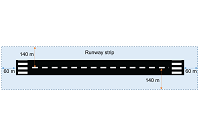A Study on the Risk Probability of Risk Mitigation Alternatives at Non-Compliance Airport with Runway Strip Criteria
DOI:
https://doi.org/10.46604/ijeti.2023.11203Keywords:
runway strip, runway excursion, runway displaced threshold, risk probability, risk mitigation alternativeAbstract
A runway strip is defined as the surface surrounding a runway established or suitable for reducing the risk of damage to aircraft in the event of a runway excursion. This study aims to implement the RSARA and LRSARA models at an airport not meeting the runway strip dimension criteria required by standards for aerodrome physical characteristics. The airport is considering alternatives to secure the runway strip criteria such as the displaced threshold and runway length extension, which is predicted to reduce the runway excursion probability. As the results of this study, it was discovered that the risk probability increases with the increases of the displaced runway distance due to relatively reduced runway length. Therefore, a reduced runway length to meet runway strip criteria may not be the most effective risk mitigation alternative, and it should be acknowledged that such a strategy can harm aviation Safety.
References
Annex 14, Aerodromes–Vol. I, Aerodrome Design and Operation, AN14-1, 2018.
Airport Facilities Act, Article 2 (Definitions), 2021.
R. M. A. Valdés, F. G. Comendador, L. M. Gordún, and F. J. S. Nieto, “The Development of Probabilistic Models to Estimate Accident Risk (Due to Runway Overrun and Landing Undershoot) Applicable to the Design and Construction of Runway Safety Areas,” Safety Science, vol. 49, no. 5, pp. 633-650, June 2011.
FAA, “AC 150/5300-13B Airport Design,” pp. 1-11, https://www.faa.gov/documentLibrary/media/Advisory_Circular/150-5300-13B-Airport-Design.pdf, 2022.
Boeing Statsum 1959-2020, “Statistical Summary of Commercial Jet Airplane Accidents-Worldwide Operation,” September 2021.
Y. H. Chang, H. H. Yang, and Y. J. Hsiao, “Human Risk Factors Associated with Pilots in Runway Excursions,” Accident Analysis & Prevention, vol. 94, pp. 227-237, September 2016.
M. Ayres Jr, H. Shirazi, R. Carvalho, J. Hall, R. Speir, E. Arambula, et al., “Modelling the Location and Consequences of Aircraft Accidents,” Safety Science, vol. 51, no. 1, pp. 178-186, January 2013.
S. Szabo, P. Vittek, J. Kraus, V. Plos, A. Lalis, M. Štumper, et al., “Probabilistic Model for Airport Runway Safety Areas,” Transport Problems, vol. 12, no. 2, pp. 89-97, 2017.
L. Moretti, P. Di Mascio, S. Nichele, and O. Cokorilo, “Runway Veer-Off Accidents: Quantitative Risk Assessment and Risk Reduction Measures,” Safety Science, vol. 104, pp. 157-163, April 2018.
P. Di Mascio, M. Cosciotti, R. Fusco, and L. Moretti, “Runway Veer-Off Risk Analysis: An International Airport Case Study,” Sustainability, vol. 12, no. 22, November 2020.
ICAO, “PANS-Aerodrome Seminar-Case Study-Wellington,” https://www.icao.int/MID/Documents/2017/PANS%20AD%20Seminar-Workshop/2-10%20Case%20Study-Wellington%20Aerodrome.pdf, 2017.
Standard for Design of Aerodrome and Landing Fields (No. 2022-350), 2022.
National Academies of Sciences, Engineering, and Medicine, Analysis of Aircraft Overruns and Undershoots for Runway Safety Areas, Washington, DC: The National Academies Press, 2008.
National Academies of Sciences, Engineering, and Medicine, Improved Models for Risk Assessment of Runway Safety Areas, Washington, DC: The National Academies Press, 2011.
National Academies of Sciences, Engineering, and Medicine, Development of a Runway Veer-Off Location Distribution Risk Assessment and Reporting Template, Washington, DC: The National Academies Press, 2014.
D. H. Kim and S. B. Hong, “An Application of the Improved Models for Risk Assessment of Runway Safety Areas,” Journal of the Korean Society for Aviation and Aeronautics, vol. 23. no. 2, pp. 1-6, June 2015. (In Korean)
S. Galagedera, H. R. Pasindu, and V. Adikariwattage, “Evaluation of the Impact of Runway Characteristics on Veer-Off Risk at Rapid Exit Taxiways,” Transportation Research Interdisciplinary Perspectives, vol. 12, article no. 100480, December 2021.
T. Dilshod, “The Risk Assessment of Aircraft Runway Overrun and Veer-off Accidents and Incidents. Case Study: Ulsan Airport,” Ph.D. thesis, Natural and Applied Sciences, Hanseo University, Chungcheongnam-do, Seosan-si, 2016. (In Korean)

Published
How to Cite
Issue
Section
License
Copyright Notice
Submission of a manuscript implies: that the work described has not been published before that it is not under consideration for publication elsewhere; that if and when the manuscript is accepted for publication. Authors can retain copyright in their articles with no restrictions. Also, author can post the final, peer-reviewed manuscript version (postprint) to any repository or website.

Since Jan. 01, 2019, IJETI will publish new articles with Creative Commons Attribution Non-Commercial License, under Creative Commons Attribution Non-Commercial 4.0 International (CC BY-NC 4.0) License.
The Creative Commons Attribution Non-Commercial (CC-BY-NC) License permits use, distribution and reproduction in any medium, provided the original work is properly cited and is not used for commercial purposes.







.jpg)


